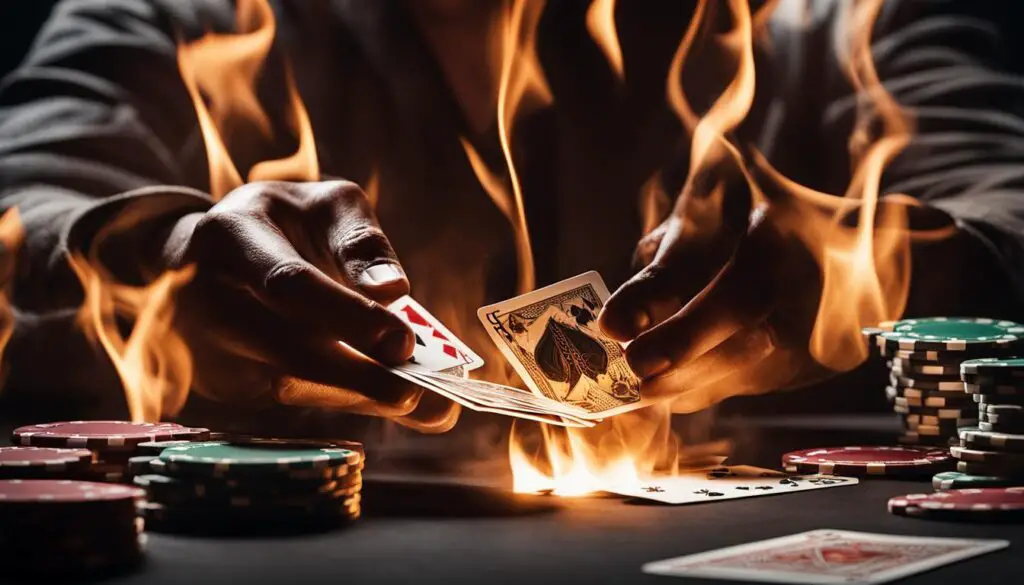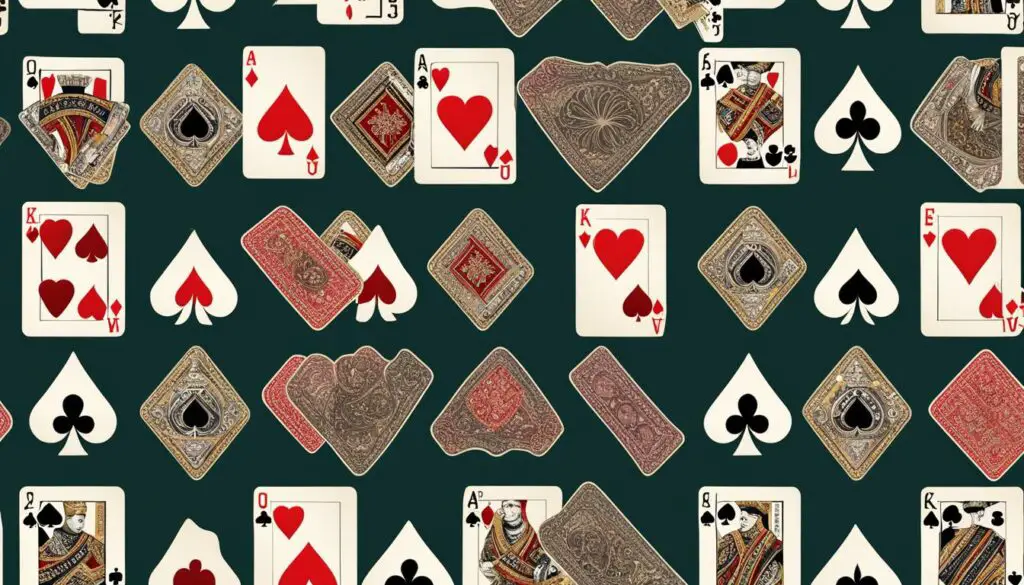In the world of poker, burn cards play a mysterious yet essential role. Have you ever wondered why these cards are burned during the game? We’re here to reveal the purpose and significance of burning cards in poker, shedding light on this intriguing practice.
But first, let’s dive into the rationale behind burning cards. By removing the top card from the deck and discarding it face down, burn cards add an extra layer of fairness and integrity to the game. This simple act prevents any cheating or manipulation by eliminating the possibility of players knowing what cards will come next.
The primary objective of burning cards is to inject randomness and unpredictability into the game, making it more challenging and exciting for all participants. Additionally, burning cards helps maintain the integrity of the deck, ensuring that no marked or damaged cards are used.
Key Takeaways:
- Burning cards in poker prevents cheating and manipulation by removing the ability to predict upcoming cards.
- It adds an element of surprise and strategy to the game, making it more challenging and engaging.
- Burning cards helps maintain the integrity of the deck, ensuring fair gameplay.
- By discarding one card every round, burning cards injects randomness into the game and eliminates insider knowledge.
- The practice of burning cards enhances the overall poker experience for players.
How Burning Cards Works in Texas Hold’em
In the game of Texas Hold’em, burning cards is a fundamental practice that ensures fairness and integrity. After the players receive their hole cards, the dealer follows the burn card rule by discarding the top card from the deck without revealing it to anyone. This action is crucial as it eliminates the possibility of players gaining knowledge about the upcoming cards, maintaining the unpredictability of the game.
https://www.youtube.com/watch?v=_j93s2vVVhk
The burn card is then followed by the community cards being dealt face-up on the table. This process is repeated for each round of betting, further reducing the chances of players predicting the next cards. By adhering to the burn card rule, Texas Hold’em ensures that the game relies on skill, strategy, and the luck of the draw, rather than any form of cheating or manipulation.
Enhancing Fairness and Strategy
Burning cards in Texas Hold’em adds an element of surprise and strategy to the game. Not knowing which cards will be revealed keeps the players engaged and forces them to make decisions based on the information they have at hand. It levels the playing field by preventing any player from gaining an unfair advantage through knowledge of upcoming cards.
“The burn card rule in poker, especially in Texas Hold’em, plays a crucial role in maintaining the integrity of the game and ensuring a fair and transparent gameplay experience.”
Additionally, burning cards helps to maintain the integrity of the deck. It prevents the use of marked or damaged cards that could potentially give certain players an unfair advantage. By discarding the top card each round, the deck remains clean and unbiased, providing a fair platform for all players to showcase their skills and compete.
- Prevents cheating and manipulation
- Enhances unpredictability and excitement
- Maintains the integrity of the deck
Overall, understanding how burning cards works in Texas Hold’em is essential for any poker player. It ensures a fair and transparent gaming experience, where luck and skill are the determining factors, allowing for an enjoyable and strategic gameplay.
The Significance of Burning Cards in Poker
In the game of poker, burning cards holds great significance for ensuring fairness and minimizing the risk of cheating or manipulation. When a card is burned, it is discarded from the deck before revealing the community cards. This practice eliminates the possibility of players gaining an advantage or predicting the upcoming cards, making the game more unpredictable and reliant on skill and strategy rather than luck or insider knowledge.
Burning cards also plays a crucial role in maintaining the integrity of the deck. By removing one card from the deck each round, any marked or damaged cards are prevented from being used in the game. This ensures that all players have an equal chance of receiving unbiased and fair cards. The practice of burning cards helps to create a level playing field for all participants and ensures that the outcome of the game is determined solely by the players’ abilities.
“Burning cards ensures fairness and prevents cheating or manipulation in poker games. By removing the possibility of players knowing the upcoming cards, it adds an element of surprise and strategy to the game, making it more exciting.”
Overall, the significance of burning cards in poker cannot be overstated. It is a fundamental practice that upholds the integrity and fairness of the game. By eliminating the chance of players gaining an unfair advantage and maintaining the integrity of the deck, burning cards ensures that poker remains a game of skill, strategy, and chance, providing an enjoyable and transparent gameplay experience for all.

Benefits of Burning Cards in Poker
Burning cards in poker offers several significant benefits that contribute to the fairness and excitement of the game. Here are some key advantages:
- Prevents Cheating: Burning cards eliminates the possibility of players gaining information about the upcoming cards, ensuring a level playing field for all participants. With the top card discarded before each round, players cannot manipulate or cheat by having knowledge of the next card in the deck.
- Enhances Unpredictability: The practice of burning cards adds an element of unpredictability and excitement to the game. By removing the visibility of the top card, it becomes challenging for players to anticipate the cards that will be dealt next, keeping them engaged and strategizing throughout the gameplay.
- Maintains Deck Integrity: Burning cards helps to maintain the integrity of the deck by preventing the use of marked or damaged cards. This ensures fairness and unbiased gameplay, as only pristine and unaltered cards are used.
- Fosters Strategic Thinking: With the randomness introduced by burning cards, players are encouraged to rely on their skill, knowledge, and strategic thinking, rather than relying solely on luck. The element of surprise created by burning cards necessitates adaptability and careful decision-making from players.
Overall, the benefits of burning cards in poker contribute to a more equitable, unpredictable, and skill-based gameplay experience.
Understanding Poker Hand Rankings
In order to fully enjoy the game of poker, it is essential to have a good understanding of the various poker hand rankings. These rankings determine the value of each hand and play a crucial role in determining the winner of each round. Poker hands are ranked from highest to lowest, with the royal flush being the highest-ranking hand and the high card being the lowest-ranking hand.
The different poker hand rankings are as follows:
- Royal Flush: This is the best possible hand in poker, consisting of the Ace, King, Queen, Jack, and Ten of the same suit.
- Straight Flush: This is a hand that consists of any five consecutive cards of the same suit. For example, 5, 6, 7, 8, and 9 of hearts.
- Four of a Kind: This hand contains four cards of the same rank, such as four Aces.
- Full House: A full house consists of three cards of one rank and two cards of another rank. For example, three Kings and two Queens.
- Flush: This hand contains any five cards of the same suit, not in sequential order.
- Straight: A straight is a hand that contains any five consecutive cards of different suits. For example, 3, 4, 5, 6, and 7.
- Three of a Kind: This hand contains three cards of the same rank. For example, three Jacks.
- Two Pair: A two pair hand contains two cards of one rank and two cards of another rank. For example, two Aces and two Kings.
- One Pair: This hand contains two cards of the same rank. For example, two Queens.
- High Card: If no player has any of the above hands, the hand with the highest-ranked card wins.
By understanding these hand rankings, players can better assess the strength of their hands and make informed decisions during gameplay. It also adds an additional layer of excitement and strategy to the game, as players aim to achieve the highest-ranking hand possible.

The Role of Estimation in Agile Software Development
Estimation plays a crucial role in agile software development. It helps product owners prioritize the backlog and make informed decisions about the level of effort required for each work item. Estimation provides valuable insights into the complexity, risk, and effort involved in implementing a feature or fixing a bug.
By involving the entire team, including developers, designers, testers, and deployers, in the estimation process, a more accurate and comprehensive understanding of the work is achieved. Each team member brings their unique perspective and expertise, contributing to a more informed estimation. This collaborative approach fosters a sense of ownership and accountability among team members, leading to better work planning and execution.
“Estimation provides valuable insights into the complexity, risk, and effort involved in implementing a feature or fixing a bug.”
Estimation also helps in setting realistic expectations, managing resources effectively, and delivering high-quality software within the given timeframes. By having a clear understanding of the effort required for each work item, project managers and stakeholders can make informed decisions and adjust project timelines accordingly. This ensures that projects stay on track and are delivered on time.
Overall, estimation is an essential practice in agile software development. It empowers teams to plan, prioritize, and execute their work effectively, leading to successful project outcomes.

Using Story Points for Agile Estimation
When it comes to agile estimation, using story points is a widely adopted and effective method. Story points provide a way to measure the overall effort required for implementing a product backlog item or any other piece of work. They are assigned based on factors such as complexity, amount of work, and level of risk or uncertainty involved. By using story points, teams can break down work into smaller pieces and address uncertainties effectively, resulting in better planning and prioritization.
One of the advantages of using story points is that they help in understanding the team’s velocity and capacity. By tracking the number of story points completed by the team over time, it becomes easier to estimate how much work can be done in a given sprint or iteration. This allows for better resource allocation and ensures that the team is not overwhelmed with excessive workloads.
The Benefits of Using Story Points in Agile Estimation:
- Improved accuracy: Story points provide a more accurate representation of the effort involved in completing a task compared to other estimation methods such as time-based estimates. This is because story points focus on the complexity of the work rather than the time it takes to complete.
- Collaborative approach: The process of assigning story points typically involves the entire team discussing and agreeing on the effort required. This fosters collaboration and ensures that estimates are based on collective knowledge and experience.
- Adaptability: Story points allow for better adaptability as they are not tied to specific time constraints. This means that if there are any changes or uncertainties during the project, the team can easily adjust their plans and priorities based on the story point estimates.
It’s important to note that story points should not be used to judge individuals or measure productivity. Instead, they should be seen as a tool for understanding the size and prioritization of work. By utilizing story points in agile estimation, teams can improve their planning, prioritize effectively, and deliver high-quality software within the given timeframes.

Best Practices for Agile Estimation
When it comes to agile estimation, following best practices can help teams effectively plan and prioritize their work. Here are some key recommendations to consider:
Use Relative Estimation Techniques
One of the most effective ways to estimate in agile is by using a relative estimation technique, such as planning poker. This involves assigning story points based on the complexity, effort, and risk involved in a particular task. By involving the entire team in the estimation process, you can tap into their collective knowledge and experience, leading to more accurate estimates.
Break Down Work into Manageable Pieces
To improve estimation accuracy, it’s important to break down work into manageable pieces. Avoid estimating individual tasks larger than 16 hours (or a predefined point threshold). By breaking work into smaller chunks, you can better understand the effort required for each task and make more informed decisions about planning and prioritization.
Conduct Regular Retrospectives
Regular retrospectives are essential for improving estimation practices over time. Take the time to reflect on past iterations and recalibrate your estimates based on the actual effort required to complete tasks. This continuous improvement process will help your team refine their estimation skills and increase accuracy.
By following these best practices, your team can enhance their agile estimation process, leading to better planning, increased productivity, and successful project delivery.
FAQ
Why are burn cards used in poker?
Burn cards are used in poker to enhance the fairness and integrity of the game. They prevent cheating or manipulation by removing the possibility of players knowing what cards will come next.
How does burning cards work in Texas Hold’em?
In Texas Hold’em, the dealer burns a card every round after the players receive their hole cards. This is done to eliminate any chance of players gaining information about the upcoming cards and to maintain the integrity of the game.
What is the significance of burning cards in poker?
Burning cards in poker helps maintain fairness and minimizes the chances of cheating or manipulation. It ensures that the game remains unpredictable and relies on skill and strategy rather than luck or insider knowledge.
What are the benefits of burning cards in poker?
Burning cards in poker prevents card manipulation or cheating, adds excitement and unpredictability to the game, and helps maintain the integrity of the deck by ensuring fair and unbiased cards are used.
How can understanding poker hand rankings help in appreciating the importance of burning cards?
Understanding poker hand rankings helps players appreciate the importance of burning cards in maintaining a fair and unbiased game. It allows players to better understand the value of different hands and the role burning cards plays in preventing manipulation or cheating.
What is the role of estimation in agile software development?
Estimation in agile software development helps product owners prioritize work items, make informed decisions, and manage resources effectively. It provides insights into the complexity, risk, and effort involved in implementing features or fixing bugs.
How are story points used for agile estimation?
Story points are used to measure the overall effort required for implementing work items in agile estimation. They are assigned based on complexity, work amount, and level of risk or uncertainty. Story points help teams understand velocity, capacity, and allow for better planning and prioritization.
What are the best practices for agile estimation?
Best practices for agile estimation include using relative estimation techniques, breaking down work into manageable pieces, and avoiding estimating individual tasks larger than a predefined point threshold. Regular retrospectives should also be conducted to reflect on and recalibrate estimates based on past iterations.

